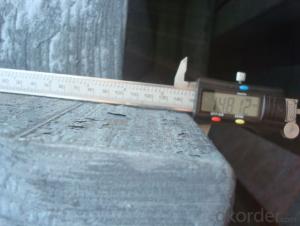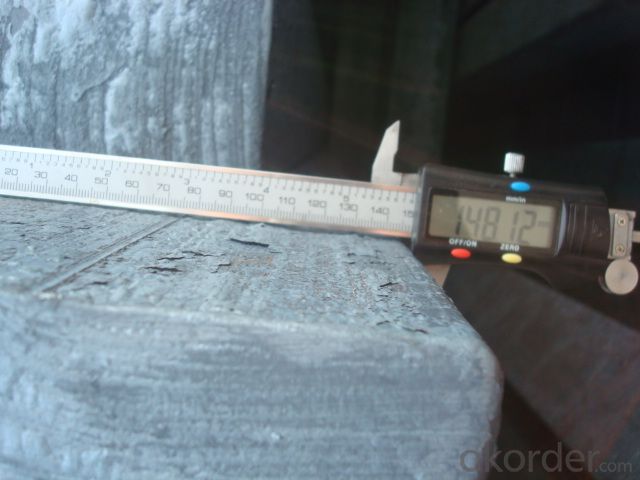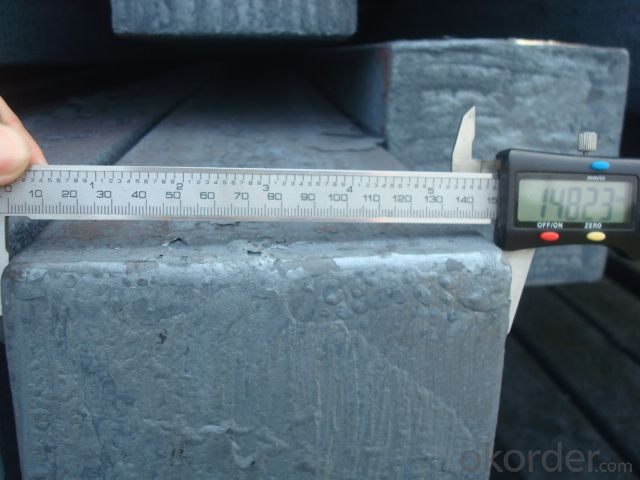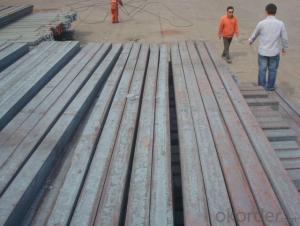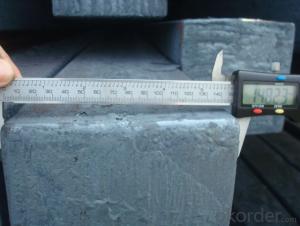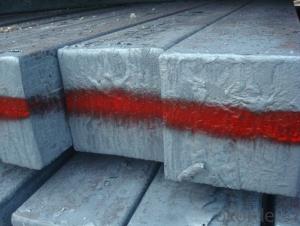Steel Bloom Manufactured by Blast Furnace According to the GB700-88
- Loading Port:
- Tianjin
- Payment Terms:
- TT OR LC
- Min Order Qty:
- 1000 m.t.
- Supply Capability:
- 100000 m.t./month
OKorder Service Pledge
OKorder Financial Service
You Might Also Like
Steel Bloom Manufactured by Blast Furnace According to the GB700-88
1.Structure of Steel Bloom Manufactured by Blast Furnace According to the GB700-88
Steel Bloom Manufactured by Blast Furnace According to the GB700-88 is the raw material of all kinds of steel mill. Billet section of square, round, flat, rectangular and abnormity, etc Several, mainly related to shape of rolled products. Simple rolled section steel, choose cross section of square billet or rectangular billet. rolling The sector products such as flat steel, Angle steel, select the rectangular billet or slab. Had better profiled billet when production beams, channels, and in rolling process Lines and improve the yield. The raw material of round billet is the production of seamless tube.
2.Main Features of Steel Bloom Manufactured by Blast Furnace According to the GB700-88
Steel Bloom Manufactured by Blast Furnace section size should meet the requirements of rolling deformation and finished product quality, but also roll strength and biting condition of restrictions. General steel Billet section height H. And the roll diameter D The ratio of the ( namely H/D) Should be less than or equal to zero 0.5 . Length of steel billet by finishing temperature, Rolling time and the length of the product Or times ruler. When heated too long accident prone to bump the furnace wall of steel, too short, furnace bottom utilization rate is not high, influence the heating furnace production. For the production Choose a variety of steel and steel billet, should consider the affinities of billet, as far as possible in order to improve the productivity of the roughing mill, simplify the stock management of workshop.
3. Steel Bloom Manufactured by Blast Furnace According to the GB700-88 Images
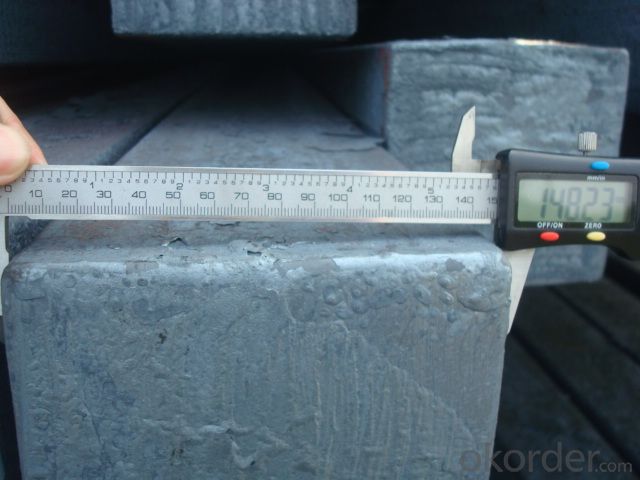
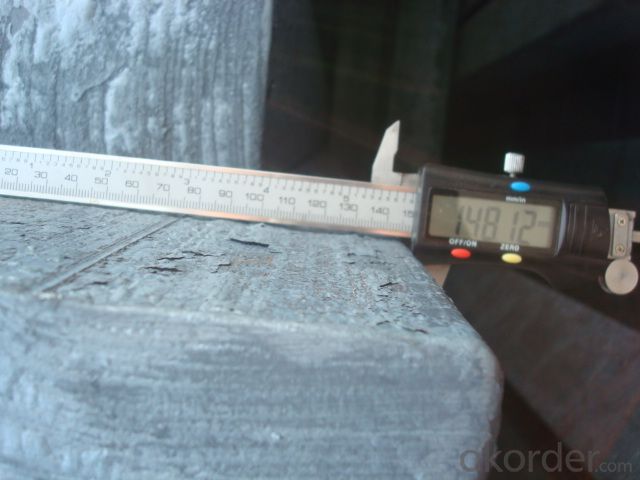
4. Steel Bloom Manufactured by Blast Furnace According to the GB700-88 Specification
Steel Bloom Manufactured by Blast Furnace rolled steel, after processing can be used for mechanical parts, forging parts, processing all kinds of steel, steel Q345B channel steel, wire rod is the role of the billet. Steel billet is used in the production of semi-finished products, generally cannot be used directly for the society. Steel billets and steel are strictly divided into standard, cannot decide to whether the business enterprise of the final product, and according to unified standards to perform the whole society. Typically, billet and the steel is relatively easy to distinguish, but for some steel billet, and have the same specification and same steel purposes (such as rolling tube billet), whether can be used for other industries, whether through steel processing process, whether through a finished product rolling mill processing to distinguish
Material standard The editor Range of thickness: 150-240 - mm + / - 5 mm width range: 880-1530 - mm + / - 20 mm Length: 3700-10000 - mm + / - 500 - mm Cross-sectional size: 64 * 64; 82 * 82; 98 * 98; 124 * 124; 120 * 150; 152 * 164; 152 * 170 mm Length: 9000 mm Section of tolerance: billet: 1.0 + / - 2.0-1.0 + / - 1.0 mm slab: width: + / - 2.0 mm thickness: + / - 3.0 mm The length tolerance: + / - 200 mm Section diagonal tolerance: 3.5-8.0 MM Billet section size protrusions requirements: < 1242 mm, do not allow; > = 1242 mm, < = 2 mm 1242 mm, < = 3 mm Beheading (shear) extension deformation: < 1242 mm billet: no control; The slab: < = 15 mm Surface tilt: no more than billet section 0.1 Bending: every 1 m length is not more than 10 mm The distortion: length < = 5 m, < = 11. ; The length of the < = 7.5 M, < = 5. Material % 3 sp/PS chemical composition: C Mn Si S P
5.FAQ of Steel Bloom Manufactured by Blast Furnace According to the GB700-88
We have organized several common questions for our clients,may help you sincerely:
①How about your company?
A world class manufacturer & supplier of castings forging in carbon steel and alloy steel,is one of the large-scale professional investment casting production bases in China,consisting of both casting foundry forging and machining factory. Annually more than 8000 tons Precision casting and forging parts are exported to markets in Europe,America and Japan. OEM casting and forging service available according to customer’s requirements.
②How to guarantee the quality of the products?
Crack in continuous casting billet surface shall not be visible to the naked eye, overlapping, skull patch, or scarring, inclusion and depth
Height is greater than the
3 mm
Scratches, indentation, scratch, pores, wrinkles, cold splash, handle, bump, pits
And depth is greater than the
2 mm
The hairline.Casting billet cross-section can not have shrinkage cavity, subcutaneous bubble.
Crack in continuous casting billet surface shall not be visible to the naked eye, overlapping, skull patch, or scarring, inclusion and depth
Height is greater than the
3 mm
Scratches, indentation, scratch, pores, wrinkles, cold splash, handle, bump, pits
And depth is greater than the
2 mm
The hairline.Casting billet cross-section can not have shrinkage cavity, subcutaneous bubble.
③How is the packaging and delivery?
Loose by Vessel and the delivery term is based on the the quantity and our factory’s schedule then.
- Q: How are steel billets recycled or reused?
- Steel billets, which are semi-finished metal products, are commonly recycled or reused in various ways. One common method of recycling steel billets is through the process of electric arc furnace (EAF) steelmaking. In this method, the billets are melted down in an electric arc furnace and then used to produce new steel products. This process not only allows for the efficient use of resources but also helps in reducing greenhouse gas emissions and energy consumption compared to primary steel production. Steel billets can also be reused in various industries such as construction, automotive, and manufacturing. They can be reshaped and reformed to create new steel products or used as raw material for forging, rolling, or extrusion processes. By reusing steel billets, the industry can reduce the demand for newly manufactured steel and conserve natural resources. Additionally, steel billets can be recycled through a process called continuous casting. In this process, the molten steel is poured into a continuous casting machine, which produces a solid billet. These billets can be further processed into various steel products such as bars, rods, or wire through hot rolling or cold rolling processes. Furthermore, steel billets can be melted and recast into other forms through the process of remelting. This can be done using technologies like induction melting or vacuum arc remelting, which help in purifying the steel and obtaining desired chemical and mechanical properties. Remelting allows for the production of high-quality steel billets that can be used in specialized applications such as aerospace, defense, or medical industries. In conclusion, steel billets are recycled or reused through various processes such as electric arc furnace steelmaking, continuous casting, remelting, and reshaping. These methods not only contribute to the sustainability of the steel industry but also help in conserving resources, reducing emissions, and meeting the growing demand for steel products.
- Q: How are steel billets used in the production of machinery and equipment?
- Steel billets play a crucial role in the manufacturing of machinery and equipment. They serve as the primary material from which different parts and components are formed. The production process begins by carefully selecting high-quality steel billets, which are then heated and shaped through techniques like hot rolling, forging, or extrusion. One important application of steel billets is seen in the production of machine parts, including gears, shafts, and axles. These billets are heated to a specific temperature, making them easy to manipulate and shape according to desired specifications. Once shaped, these parts undergo further processing, such as heat treatment or machining, to enhance their strength, durability, and precision. Steel billets are also extensively used in the manufacturing of heavy machinery and equipment. For example, in the construction industry, they form the foundation for the production of cranes, excavators, and bulldozers. By molding and shaping these billets into various structural components, the necessary strength and stability are provided for these equipment to perform arduous tasks. Additionally, steel billets find application in the production of industrial machinery, such as turbines, compressors, and pumps. Through intricate shaping, these billets acquire high strength, corrosion resistance, and the ability to withstand extreme operating conditions. The properties of steel, such as its high strength, durability, and versatility, make it an ideal material for the manufacturing of machinery and equipment. Steel billets act as the starting point for the production process, enabling manufacturers to create complex and dependable components that are vital for the operation of machinery and equipment in diverse industries.
- Q: How are steel billets used in the production of oil and gas exploration equipment?
- Steel billets are commonly used in the production of oil and gas exploration equipment due to their strength and durability. These billets are shaped and machined into various components such as valves, pumps, drilling tools, and pipelines, which are crucial for the extraction and transportation of oil and gas. The high-quality steel ensures that the equipment can withstand harsh operating conditions, including high temperatures, pressure, and corrosive environments, thereby ensuring the safety and reliability of oil and gas exploration operations.
- Q: How are steel billets used in the production of shafts?
- Steel billets are an essential component in the production of shafts. A billet is a semi-finished product that serves as the starting point for various manufacturing processes. In the case of shaft production, steel billets are used as the raw material from which the shafts are formed. The process begins by heating the steel billets to a specific temperature, typically in a furnace. This heating process, known as "hot working," is crucial as it makes the steel more malleable and easier to shape. Once the billet reaches the desired temperature, it is then transferred to a forging press or a rolling mill. In the forging process, the heated billet is subjected to high pressure and shaped using specialized dies to achieve the desired shaft dimensions. This method allows for precise control over the shape, size, and surface finish of the shaft. On the other hand, in the rolling process, the billet is passed through a series of rollers that gradually shape it into a cylindrical form. Rolling is often used for shafts that require a constant cross-section along their length. After the initial shaping process, the shafts undergo further steps such as heat treatment, machining, and finishing to meet the specific requirements of their intended application. Heat treatment helps enhance the mechanical properties of the shaft, making it stronger, more durable, and resistant to wear. Machining processes, such as turning, milling, or grinding, are then carried out to achieve precise dimensions, smooth surfaces, and accurate tolerances. Overall, steel billets play a crucial role in the production of shafts as they provide a starting point for the shaping processes necessary to create these critical components. Through careful manipulation and refinement, steel billets transform into high-quality shafts that are used in various industries, including automotive, aerospace, manufacturing, and many others.
- Q: What is the melting point of steel billets?
- The melting point of steel billets may vary depending on the type of steel utilized. In general, the melting point of steel falls within the range of 1370 to 1530 degrees Celsius (2500 to 2800 degrees Fahrenheit). However, it is worth noting that diverse grades and compositions of steel can possess slightly different melting points. Moreover, factors such as impurities, alloying elements, and the inclusion of other metals in the steel can also influence the melting point. Consequently, it is always advisable to refer to the specific material specifications or seek guidance from metallurgical experts to obtain precise information regarding the melting point of steel billets.
- Q: What are the main factors that determine the market price of steel billets?
- The main factors that determine the market price of steel billets include supply and demand dynamics, global economic conditions, raw material costs, production capacity, and government policies and regulations.
- Q: What are the physical properties of steel billets?
- Steel billets have several physical properties including high strength, excellent toughness, good ductility, and high resistance to corrosion. They are typically solid, dense, and have a metallic luster. Steel billets are also known for their high melting point and conductivity, making them suitable for various industrial applications such as construction, automotive, and manufacturing.
- Q: What are the advantages of using steel billets in construction?
- There are several advantages of using steel billets in construction: 1. Strength and Durability: Steel billets are known for their high strength and durability, making them ideal for construction purposes. They can withstand heavy loads and extreme weather conditions, ensuring the longevity and stability of the structure. 2. Versatility: Steel billets can be molded and shaped into various forms, allowing for flexibility in design and construction. This versatility makes them suitable for a wide range of applications, from beams and columns to framing and foundations. 3. Cost-effectiveness: Despite the initial cost of steel billets being higher than other construction materials, their long-term benefits outweigh the investment. Steel is low maintenance, doesn't require frequent repairs or replacements, and offers excellent fire resistance, reducing insurance costs. 4. Sustainability: Steel is a highly sustainable material due to its recyclability. Steel billets can be recycled and reused without losing their properties, reducing the demand for virgin materials and minimizing environmental impact. 5. Speed of construction: Steel billets are pre-fabricated, meaning they are manufactured off-site and then transported to the construction site. This significantly reduces construction time and allows for faster completion of projects. 6. Resistance to pests and rot: Unlike wood, steel billets are not susceptible to termites, pests, or rot. This eliminates the need for chemical treatments or regular inspections, saving both time and money. 7. Design flexibility: Steel billets offer a wide range of design possibilities, enabling architects and engineers to create unique and aesthetically pleasing structures. The ability to span large distances without the need for additional support columns allows for open floor plans and creative architectural designs. In summary, the advantages of using steel billets in construction include their strength, durability, versatility, cost-effectiveness, sustainability, speed of construction, resistance to pests and rot, and design flexibility. These factors make steel billets an excellent choice for various construction projects, ensuring sturdy and long-lasting structures.
- Q: What are the different types of steel billet defect detection methods?
- There are several different types of steel billet defect detection methods that are commonly used in the industry. These methods help identify any defects or imperfections present in the steel billets, ensuring that only high-quality products are being produced. Some of the different types of steel billet defect detection methods include: 1. Visual Inspection: This is the most basic and common method, where trained inspectors visually examine the billets for any visible defects such as cracks, surface irregularities, or deformations. While effective for detecting certain types of defects, this method may not be able to identify internal or hidden defects. 2. Ultrasonic Testing: This method uses high-frequency sound waves to detect defects within the billets. Ultrasonic waves are passed through the billet, and any irregularities or disruptions in the waves indicate the presence of defects such as cracks or voids. Ultrasonic testing is a widely used technique for detecting internal defects. 3. Magnetic Particle Inspection: This method involves magnetizing the steel billet and then applying iron particles. If there are any surface or near-surface defects, the particles will be attracted to these areas, making the defects visible. Magnetic particle inspection is particularly effective for detecting surface cracks and discontinuities. 4. Eddy Current Testing: This technique uses electromagnetic induction to detect surface or near-surface defects in steel billets. A coil carrying an alternating current is placed near the billet, and any changes in the electrical conductivity or magnetic properties of the material caused by defects are detected. Eddy current testing is particularly useful for detecting surface cracks and corrosion. 5. X-ray Testing: X-ray inspection involves passing X-ray radiation through the steel billet and capturing the resulting image on a film or digital detector. Any internal defects such as cracks, voids, or inclusions will show up as dark spots on the X-ray image. X-ray testing is highly effective for detecting internal defects. 6. Laser Scanning: This method uses a laser scanner to create a three-dimensional image of the steel billet's surface. Any irregularities or deformations in the surface can be detected and analyzed using specialized software. Laser scanning is a precise and efficient method for detecting surface defects. These are just a few of the different types of steel billet defect detection methods that are commonly used in the industry. Each method has its own advantages and limitations, and the choice of method depends on factors such as the type of defect being targeted, the size and shape of the billets, and the level of precision required. By employing these defect detection methods, manufacturers can ensure the production of high-quality steel products.
- Q: How are steel billets used in the shipbuilding industry?
- Steel billets are used in the shipbuilding industry as a primary raw material for manufacturing various components of a ship's structure, such as hulls, decks, and bulkheads. These billets are melted, cast, and then rolled into the desired shape or size to meet the specific requirements of the ship's design. The high strength and durability of steel make it ideal for withstanding the harsh marine environment and ensuring the structural integrity of the vessel.
Send your message to us
Steel Bloom Manufactured by Blast Furnace According to the GB700-88
- Loading Port:
- Tianjin
- Payment Terms:
- TT OR LC
- Min Order Qty:
- 1000 m.t.
- Supply Capability:
- 100000 m.t./month
OKorder Service Pledge
OKorder Financial Service
Similar products
Hot products
Hot Searches
Related keywords
